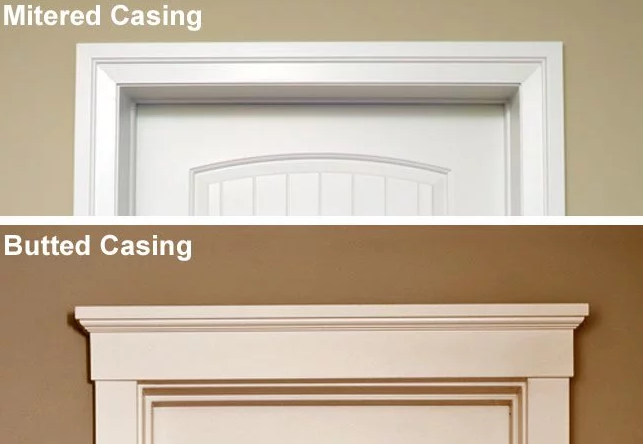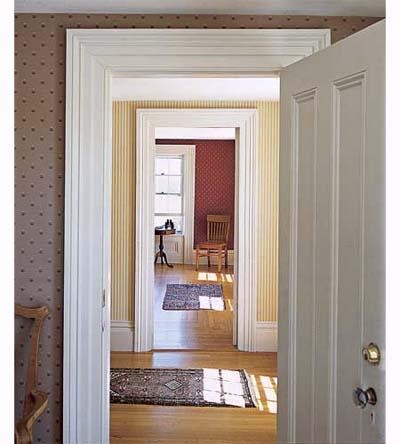Free Bay Area delivery on orders over $275. Orders will ship next business day. View Shipping/Return Policy.

Adding a decorative door casing to an entryway is one of the easiest ways to create architectural interest in any room in your home. It’s an easy do-it-yourself project that just about any homeowner can complete in a weekend. But with all the choices out there, how do you choose the best style for your home?
There are many door casings styles, and you may have a vastly different idea of what looks nice in your home compared to the next person. At The Moulding Company, we’ve helped many homeowners and contractors choose a suitable door casing for their projects that complement a particular style. Read on for a quick primer on door casings and helpful tips to get you started.
What Is Interior Door Casing?
Interior door casing is the term used to describe the trim found around a door opening. According to This Old House, “Door casings are both decorative and utilitarian, enhancing the look of the door while also concealing the transition between the wall and the jamb.”
Basic doorway casings are three separate pieces – two long trim pieces on either side of the door frame topped with a shorter piece called the head casing to complete the framing.
Historically, door trim has set the tone for a room. In the Victorian-era 19th century, designs used fluted boards butted against decorative corner blocks called rosettes. These designs were symmetrical and used a uniform pattern across their faces.
Tapered casings, created by building up several profiles from the inside of the door jamb to the outer edge, were common in 19th century Federal and Italianate homes and later in Greek Revival and Colonial styles that prized depth and dimension. Today, door casings come in a range of styles, from clean and simple to ornate and elegant.
Mitered vs. Butted Door Casings

To better understand which door casings might be best for your home, it helps to know the difference between mitered and butted door casings.
- Mitered casings connect the three parts—side pieces and header casing—using angled, or mitered, joints. Mitered casings can be plain or elaborate with intricate details.
- Butted door trim combines two side casing boards with a wider head casing that rests directly on top. The wide head casing tends to draw the eye upward, making this style an excellent choice for homes with high ceilings. Enhance the effect of drawing the eye upward by using intricate patterns or details in the head casing.
No matter which style of casing you choose, you may incorporate rosettes for a decorative flourish that adds a bit extra to the look of doors and windows in your home.
Do You Need Door Casing Ideas?
As previously discussed, the door casing you choose for your home can significantly impact the look and feel of the room you are entering. If you have a vision for how you want your home to look, these door casing ideas can help you get a feel for what’s available.
Colonial Style Casing
The Colonial-style casing is a classic door casing found in many homes throughout the United States. It features raised edges and mitered corners and complements many homes thanks to its simple, elegant look without excess frills.

Ripple Effect
This door casing features mitered corners and is built from the inside of the door jamb outward. It combines several layers of varying sizes to achieve a complex yet attractive design that would feel right at home in any 19th-century Victorian-era home or new Colonial Revival.

Simple Elegance
An example of a butted door casing that combines flat side casings with a well-defined header casing and crown showcases simple elegance. A doorframe like this can enhance the coziness and welcoming of a room and is suitable for many home styles.

Need more inspiration? Check out our site for a wide range of door casing profiles, or visit one of our showroom locations to see up-close examples.
Tips for Choosing Door Casings
Selecting door trim for your home doesn’t have to be complicated or overwhelming. While there are many wood casing options to choose from, there are some steps you can take and places you can start so you get a suitable trim without feeling like you’re settling for something you don’t love.
Start Where You Are
Unless you are building a brand new home, your current structure likely already has some moulding and a particular style. In other words, it’s essential to choose door casings that closely match or complement your existing base moulding, window casings, crown moulding, etc. Unless you plan to change all of the trim throughout a particular room, it’s best to take design cues from what you already have.
For example, if your baseboards and window trim is flat and mitered, your door casings should follow suit. Also, be sure to match the thickness of the case moulding you’re considering to the casing around windows or other doors in the room.
Consider the Style of Your Home
Some architectural styles create an air of formality that calls for more intricately designed trim options. Victorian homes, for example, are renowned for their intricate woodwork, soaring ceilings, and elegant crown moulding. On the other hand, Ranch-style homes tend to be much less formal, using simple trim lines that create a casual look and feel. Let the external style of your home dictate trim options on the inside to create a cohesive look.
Don’t Be Afraid to Add Your Own Style
If you intend to replace all of the moulding in a particular room or throughout the entire home, feel free to get creative with your moulding choices. Make notes on styles you like and bring home samples to get a sense of how they might work in your space.
You might also explore using some of the existing moulding profiles, but choose a different material or color scheme to put your spin on it. For example, change plain white door casings with solid wood options in your choice of stain. Or, add a pop of color to compliment an otherwise bland room.
Get Help from the Experts
There’s no doubt that there are plenty of choices for adding door casings to your home. But understanding door casing terminology and using your existing moulding as a reference should give you a great starting point to search for the perfect door casings for your home and personal style.
Rather than wandering through a home improvement store or lumber yard searching for matching case moulding, visit a moulding specialist like The Moulding Company, based in the San Francisco Bay area. Visiting a moulding showroom where you can talk with experts will allow you to ask questions and even get samples to take home.
Whether you’re looking for unique moulding options or want affordable moulding for every room in your house, The Moulding Company offers a huge selection of in-stock trim, moulding, baseboards, crown moulding, window casings, and much more. Homeowners throughout northern California and the San Francisco Bay area get FREE delivery on all orders over $275.

